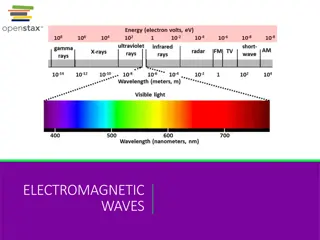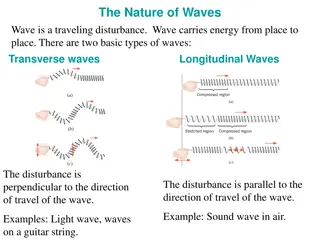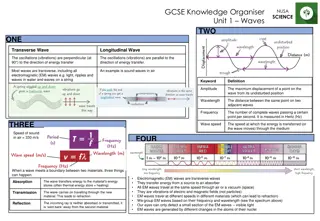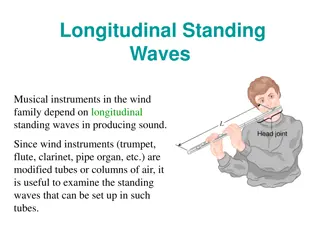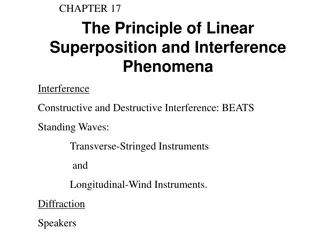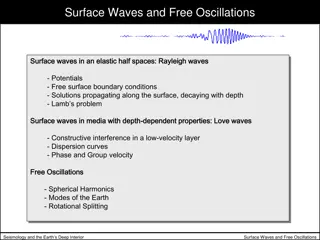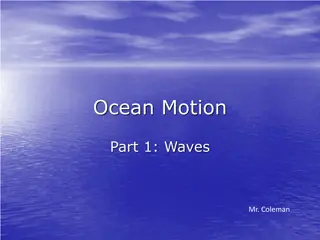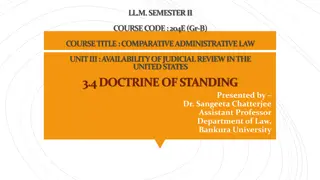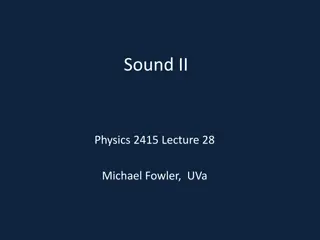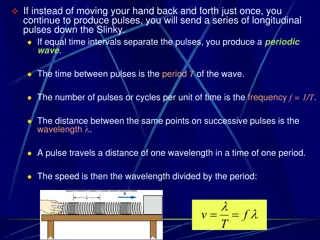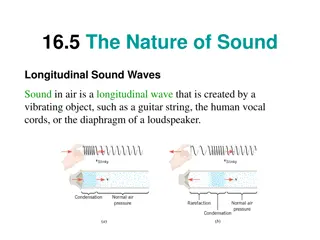Understanding Standing Waves in Three Dimensions
Exploring the concepts of normal modes, wave equations, and standing waves in three-dimensional spaces, including the derivation of wave functions within rectangular enclosures and the calculation of normal mode frequencies. The content discusses boundary conditions, particular wave functions, and degenerate standing waves, providing a comprehensive understanding of wave behaviors in complex spatial configurations.
Download Presentation

Please find below an Image/Link to download the presentation.
The content on the website is provided AS IS for your information and personal use only. It may not be sold, licensed, or shared on other websites without obtaining consent from the author. Download presentation by click this link. If you encounter any issues during the download, it is possible that the publisher has removed the file from their server.
E N D
Presentation Transcript
Normal modes in three dimensions 26THNOVEMBER 2019 1
Waves equation in 3 dimensions Recall, the wave equation in 3 dimensions can be written as 2 2 2 2 1 c + + = 2 2 2 2 2 x y z t The solution of the equation can be found from the method of separation of variables. The general solution, i.e., the wave function, is found to be sin cos sin cos sin cos sin cos = A k x k y k z ckt 1 2 3 2
Standing waves in rectangular enclosure Consider a rectangular enclosure as illustrated in the figure, l1, l2 and l3 are lengths of the sides of the rectangular enclosure. The wave function describing the standing waves inside the enclosure have to satisfy the following boundary conditions. (0,0,l3) z (0,l2,0) y l2 = = = = = l3 = 0 0 and 0 x y z x y z l l l 1 = 0 @ 2 x (0,0,0) (l1,0,0) 3 l1 3
A particular wave function within the rectangular enclosure By applying the first boundary condition, = 0 @ x = y = z = 0 at all times, the wave function becomes = sin sin sin sin A k x k y k z kct 1 2 3 Likewise, the application of the second boundary condition, = 0 @ x = l1, y = l2 and z = l3 at all times, leads to the particular wave function n n A x l l n 3 l 1 2 = sin sin sin sin y z kct 1 2 3 where n1, n2 and n3 are integers. 4
Normal mode frequency of standing wave in a rectangular enclosure Substituting the particular wave equation into the 3 D wave equation, we then obtain 2 2 1 2 n n l l 2 n 2 3 l + + = k 1 2 3 2 2 2 The allowed standing wave must have wave vectors that satisfy this condition. This leads to n n n 2 3 l 1 l 2 l + + = k 1 2 3 2 2 2 2 2 Or n 2 2 n n 3 l 1 l 2 l + + = = c 1 2 3 1 2 2 2 2 Finally, the normal mode frequency ; n l n l n l c 3 1 2 = + + 2 1 2 3 5
Normal mode frequency Recall the normal mode frequency from the previous slide, 1 2 2 2 2 n l n l n l c 3 1 2 = + + 1 2 3 n n n 2 1 2 3 The labels; i.e., n1n2n3, need not all have the same value, but can be chosen quite independently of each other. Note that, setting any one of them equal to zero causes the wave function to vanish. Likewise, the wave function can be expressed with the label n1n2n3 as follows n n A x l l n 3 l 1 2 = sin sin sin sin y z kct 1 2 3 n n n 1 2 3 6
Degenerate standing waves Recall the relationship of the wave vectors k, k1, k2 and k3, 2 2 2 n n n 2 2 1 2 2 2 3 3 l 1 l 2 l = + + = + + k k k k 1 2 3 This implies that standing waves with different composite wave vectors can have the same wave vector k, normal mode frequency and subsequently energy. Those standing wave are called degenerate waves functions . For example, if l2 = 2l1 for any value of n3, 22n3 and 14n3 are degenerate wave functions. 7
No. of normal mode frequency in a rectangular enclosure in k space No. of normal mode frequency, representing the no. of standing waves in the rectangular closure, can be determined from either wave vector space k or frequency space . 2 2 2 n n n If we start the analysis with the wave vector relation, 2 2 1 2 2 2 3 3 l 1 l 2 l = + + = + + k k k k 1 2 3 The composite components of the wave vector k k3 can form three perpendicular axes. Also, it is noted that the maximum magnitude of the wave vector k has to be within a sphere of radius k. k k2 k1 Wave vector space k 8
The lowest normal mode Consider the lowest normal mode having labels of n1n2n3 = 111, the magnitude of the wave vector k becomes each apparent point corresponds to a possible normal mode. 1 2 2 2 2 k3 = + + k l l l 1 2 3 The end point of the lowest normal mode wave vector is at the corner of a rectangular cell having lengths /l1, /l2, /l3 along k1, k2 and k3, respectively, with a volume 3/l1l2l3 . There are as many cells as points since each cell has eight points at its corners and each point serves as a corner to eight cells. 3 k k = + + k k i k j 1 2 k2 /l3 /l1 /l2 Therefore, this suggests that the number of modes can be determined from the ratio of the spherical volume to the volume of a cell. However, only one octant of the sphere gives a unique set of normal mode. k1 Wave vector space k http://hyperphysics.phy-astr.gsu.edu/hbase/quantum/rayj.html 9
The number of normal modes 1 spherical volume The number of normal modes can be calculated from No. of modes = 8 volume of a cell https://slideplayer.com/slide/13669157/ 10
No. of normal mode frequency in a rectangular enclosure in space The wave vector space can be transformed into the frequency space as follows 2 2 1 2 n n k l l 2 2 n 3 l = + + 1 2 3 1 2 3 2 2 2 n l n l n l c 3 1 2 = + + 1 2 3 n n n 2 1 2 3 Likewise, the frequency space is composed of composite frequency components 1, 2 and 3 as shown in the figure. The maximum normal mode frequency lies within the sphere of radius . 2 1 frequency space 11
The lowest normal mode frequency This lattice cell correspond to the lowest normal mode frequency 111. 12
How many normal modes can exist in the frequency range to + d ? The total normal mode corresponds to the number of possible points (n1, n2, n3) lying in the positive octant between two concentric sphere of radii and + d . The total number of possible points or cell will be ( volume of spherical shell 1 8 volume of a cell This came from the volume of the fundamental mode, c3/8l1l2l3. ) 2 8 l l l 4 d 1 2 3 3 c d c = 8 2 1 2 3 l l l = 4 3 2 4 d Note that the mode density is given by in the frequency range to + d 3 c per unit volume of enclosure. 13
Application of mode density : Rayleigh-Jean radiation law Rayleigh and Jean attempted to find an oscillator model describing the EM radiation from a hot body of temperature T. The average energy of each normal mode is given as 2kT. Therefore, the EM energy radiated by a hot body of temperature T in the small frequency interval to + d may be written as 2 4 2 E d kT c This relation leads to the ultra-violet catastrophe. ( ) 1 h kT e h d = 3 From Planck Black body radiation curves described by Planck (dashed lines) and Rayleigh-Jean (solid line) 14
Application of mode density : Debye theory of specific heat of a solid By definition, the specific heat is the amount of heat energy that must be supplied to a mole of solid to raise its temperature by one degree. Debye realized that the solid should be treated as a continuum instead of looking into the vibrations of the individual atoms as was done by Einstein. He considered the thermal vibrations of atoms in a solid lattice in terms of a vast complex standing waves due to coupled oscillation over a great range of frequencies. In Debye s model, each atom was allowed two transverse vibrations (perpendicular planes of polarization) and one longitudinal vibration. The possible mode density in the frequency interval to + d is given by 2 1 4 T L c c 2 CT and CL are the transverse and longitudinal velocities. = + dn d 3 3 15
Debyes approximation Once the mode density in the frequency range to + d and an average energy (form Planck s law) are known. The total energy for a solid volume VA is then h V dn V e 2 1 c 2 = + 4 d A A h kT 3 T 3 L 1 c The total energy per one mole of atoms of the solid over all permitted frequencies is then 3 m 2 1 c h = = + 4 E V dn V d A A A h kT 3 T 3 L 1 c e 0 Where m is the maximum frequency of the oscillations. The total number of modes can be written in terms of the maximum frequency of the oscillations as follows: 16
Because the amount of solid under interest is one mole, there are N atoms (Avogadro s number). Each atom has three allowed oscillation modes; i.e. two transverse and one longitudinal modes. Thus the mode density (or the number of normal mode frequencies per unit volume) for one mole of a solid volume VA is given as m 4 2 1 c 2 1 c V 2 3 m A = = + = + 3 4 dn N V d A 3 T 3 L 3 T 3 L 3 c c 0 By substituting the above expression into EA from previous slide, 17
The values of EA becomes 2 m 9 N = E d A h kT 3 m 1 e 0 The molar specific heat of the substance at constant volume can be determine once the variation of EA with temperature has been found. E T A = c In general, the specific heat is calculated from V The specific heat of aluminum calculated by this model is compared with experiment results shown in the next slide. 18


